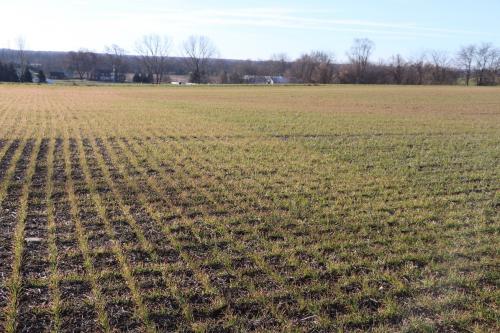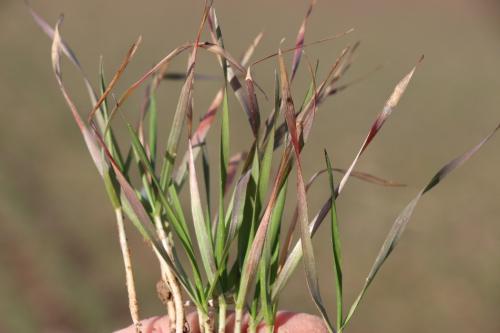Purple leaves on wheat explained
Cold, wet conditions have caused poor wheat growth and development. Scout your fields now to evaluate your stands.

Wheat fields across much of Michigan’s Lower Peninsula are showing signs of purpling, yellowing and tip burn. This has become a widespread problem this fall. Temporary phosphorus deficiency can cause purpling of plant leaves. This can happen late in the fall or early in the spring when soils are cool and wet. When the soil is cold and wet, phosphorus uptake slows. Phosphorus is needed in the plant to transport sugars into the phloem from “sources” to “sinks” where the sugars are needed.
Even in the colder temperatures, chloroplasts inside the leaves continue to absorb sunlight and produce sugars. Anthocyanin pigments are created from cyanidin glucosides (plant sugars), which accumulate in the upper epidermis of the leaf due to slowed transport in the phloem. Sugars in the phloem move via mass flow, which is impacted by plant stresses such as cold temperatures.
In the month of October, much of Michigan received record rainfall with wet conditions persisting into November. When scouting fields, evaluate and dig plants in green areas and damaged areas. Plants in green areas seem to be associated with better drained soils and have much more established root systems. Damaged areas have little or no crown root development while green plants have crown roots 1 to 2 inches long. After sampling about a dozen fields, no root diseases have been identified. The prolonged wet conditions could be the cause for poor root development.

Some fields appear to have a golden or bright tan appearance when viewed from the road. It actually looks like the plants are dying, so you need stop, walk out in the field and dig some plants.

Upon closer inspection, you will find the purpling of the leaves along with some leaf burn caused by high winds. There is green tissue and the crowns are not damaged. Some farmers have suspected the crop was dying or dead. This is NOT the case.
Yield losses from leaf purpling and wind burn have not been documented. It is expected that as the soil drains and warms up, sugar transport will resume as normal and the purple color will disappear. However, if you suspect soil test levels are low for phosphorus, Michigan State University Extension suggests pulling soil samples and determining for sure if you need to add phosphorus fertilizer. If purpling persists even after temperatures rise, further investigation may be warranted.



 Print
Print Email
Email


